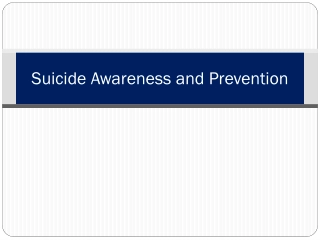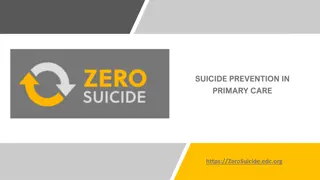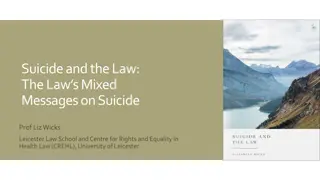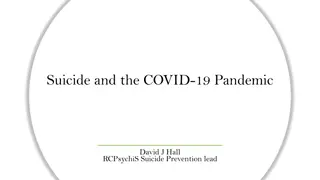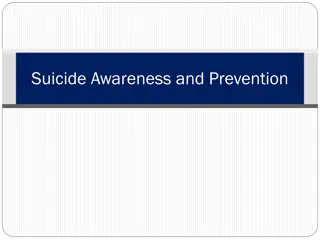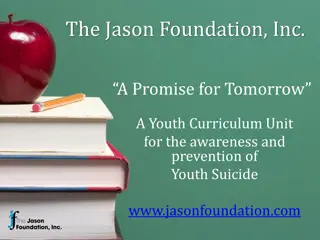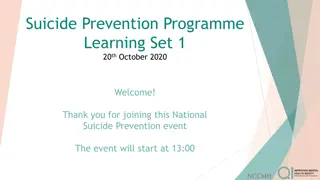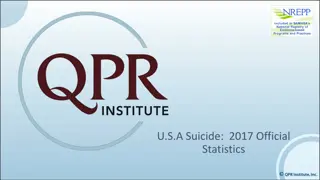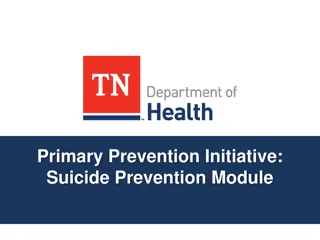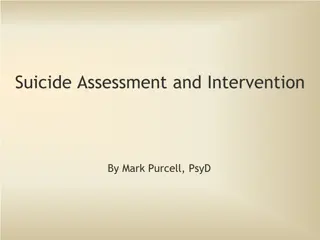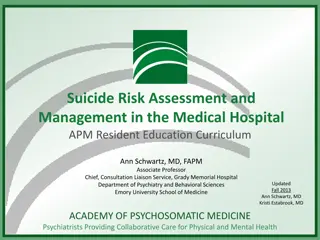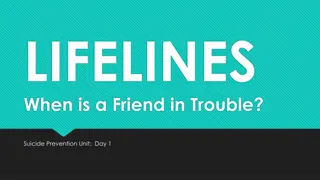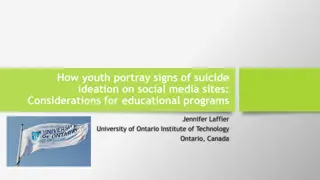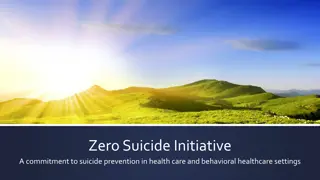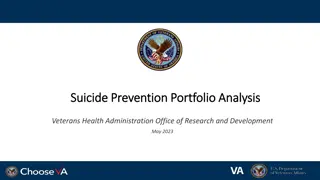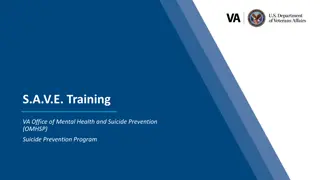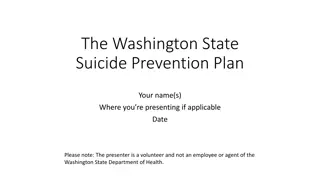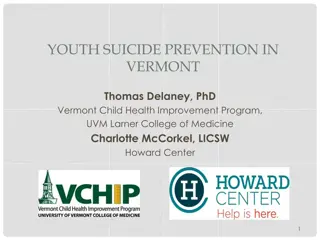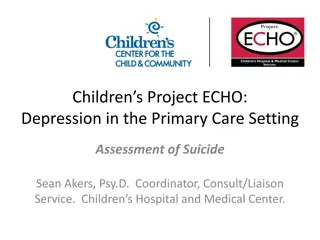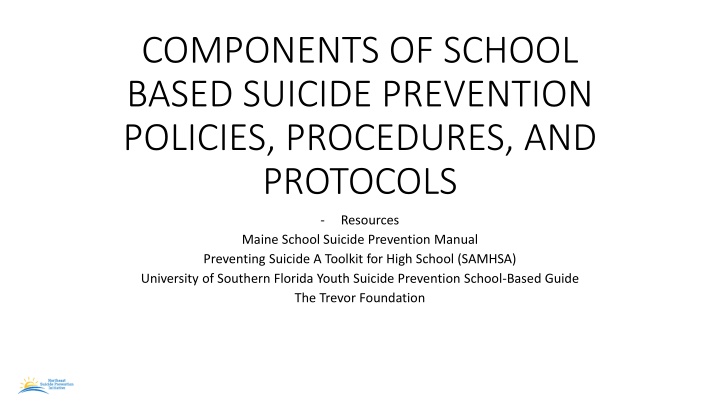
Elements of School-Based Suicide Prevention Policies & Procedures
School-based suicide prevention policies, procedures, and protocols are crucial for addressing and preventing suicide among students. This comprehensive approach includes defining at-risk students, forming crisis teams, incorporating behavioral health considerations, implementing postvention strategies, assessing suicide risk factors, and recognizing warning signs. By having a robust policy in place, educators can feel more confident in intervening with at-risk students.
Download Presentation

Please find below an Image/Link to download the presentation.
The content on the website is provided AS IS for your information and personal use only. It may not be sold, licensed, or shared on other websites without obtaining consent from the author. If you encounter any issues during the download, it is possible that the publisher has removed the file from their server.
You are allowed to download the files provided on this website for personal or commercial use, subject to the condition that they are used lawfully. All files are the property of their respective owners.
The content on the website is provided AS IS for your information and personal use only. It may not be sold, licensed, or shared on other websites without obtaining consent from the author.
E N D
Presentation Transcript
COMPONENTS OF SCHOOL BASED SUICIDE PREVENTION POLICIES, PROCEDURES, AND PROTOCOLS - Resources Maine School Suicide Prevention Manual Preventing Suicide A Toolkit for High School (SAMHSA) University of Southern Florida Youth Suicide Prevention School-Based Guide The Trevor Foundation
Why a Comprehensive Policy? Nearly every school will need to deal with this issue at some point. Having a policy in place can help educators feel more confident in intervening with a student they believe to be at risk. 2
Definitions At risk - A student who is defined as high risk for suicide is one who has made a suicide attempt, has the intent to die by suicide, or has displayed a significant change in behavior suggesting the onset or deterioration of a mental health condition. The student may have thought about suicide including potential means of death and may have a plan. In addition, the student may exhibit feelings of isolation, hopelessness, helplessness, and the inability to tolerate any more pain. This situation would necessitate a referral, as documented in the following procedures. Crisis team- A multidisciplinary team of primarily administrative, mental health, safety professionals, and support staff whose primary focus is to address crisis preparedness, intervention/response and recovery. These professionals have been specifically trained in crisis preparedness through recovery and take the leadership role in developing crisis plans, ensuring school staff can effectively execute various crisis protocols, and may provide mental health services for effective crisis interventions and recovery supports. Behavioral Health - Include mental and/or substance use disorders. Postvention- Suicide postvention is a crisis intervention strategy designed to reduce the risk of suicide and suicide contagion, provide the support needed to help survivors cope with a suicide death, address the social stigma associated with suicide, and disseminate factual information after the suicide death of a member of the school community. 3
Risk factors for suicide Characteristics or conditions that increase the chance that a person may try to take his or her life. Suicide risk tends to be highest when someone has several risk factors at the same time. Risk factors may encompass biological, psychological, and or social factors in the individual, family, and environment. Risk assessment - evaluation of a student who may be at risk for suicide, conducted by the appropriate school staff (e.g., school psychologist, school counselor, mental health or school social worker). This assessment is designed to elicit information regarding the student s intent to die by suicide, previous history of suicide attempts, presence of a suicide plan and its level of lethality and availability, presence of support systems, and level of hopelessness and helplessness, mental status, and other relevant risk factors. Warning Signs - Indications that can be behavior, verbalization, suggestions, that someone MAY be in danger of suicide, either immediately or in the future. 4
Self-harm Behavior or self-injury It is a deliberate act without intent to die. Although self-harm lacks suicidal intent, youth who engage in self-harm are more likely to attempt suicide. Suicide attempt A self-injurious behavior with intent to kill himself or herself. Suicide contagion The process by which suicidal behavior or a suicide influences an increase in the suicidal behaviors of others. More common among youth. Youth who are affected by contagion do not need to know the youth that died by suicide. Contagion can affect youth up to 2 years after a death. Suicidal ideation is relatively common and is not necessarily associated with a crisis situation. A thinking about, considering, or a desire to be dead without a plan or intent to end one s life is still considered suicidal ideation and should be taken seriously. Suicidal gestures are usually self injury that occur in the context of crisis periods, or periods that are associated with overwhelming stress, seemingly unbearable and unendurable emotional, with the thoughts of ending there life. Suicidal Crisis Intense, intense feeling of psychological pain in which there is cognitive deficits that cannot see any outcome other than ending their life. It usually lasts about 48 hours. Suicide - A self-inflicted death for which there is evidence of intent to die. 5
Policies and Procedures Establish policies and procedures that focus on issues, such as: Formally state that the school considers suicide prevention a priority. Formally state what prevention efforts the school will utilize to address adolescent suicide (curriculum, gatekeeper training, screening, peer groups). State what defines a suicidal crisis? (A suicidal crisis occurs any time when the risk for suicide is raised by any peer, teacher, or other staff member that identifies a student as potentially suicidal) What should staff, faculty, or students do if they suspect that a student may be potentially at risk for suicidal ideations and/or behavior. Describe how staff needs to respond to a student overtly expressing suicidal ideations and/or behaviors. Develop an Intervention plan. Describe the criteria for assessing the lethality of a student potentially at risk for suicidal behavior. (see levels of risk) and who should do the assessment. In all, develop a plan to designate the various roles school personnel may play in preventing, intervening, and coping with a student who may be suicidal. 6
Four major components of a school districts policy and procedures for youth suicide: Statement of Need Prevention Strategies Definition of Crisis Intervention Procedures for assessment and referrals Procedures for handling in-school attempts and out of school attempts Re-entry Procedures Procedures on parent involvement and notifications Crisis Postvention Plans 7
Develop a Crisis Plan An effective crisis plan should incorporate the following components: - Step-by-step guidelines to follow during a crisis - Roles and responsibilities of the crisis team, teachers, administrators - MOUs with community providers to assist with this task. - Follow up of individuals after the crisis A crisis plan if there is a death should provide an emergency protocol to structure and organize staff responsibilities and available resources. The purpose of the plan is to provide order and stability by pulling the school community together. It also makes students feel safer and combats suicide contagion. 8
Stages of Crises Planning Pre-Crisis Crisis Post Crisis
Training on Policies Should be Given to All Personnel It is essential that once policies are established and are agreed upon by administrators, staff, and community professionals, these policies are provided to all faculty and staff, preferably through a mandatory in-service suicide awareness and prevention training. 10
Prevention Prevention strategies are needed to minimize the risk of suicide as well as the negative impact of other serious behavioral health issues. Prevention includes staff training and suicide education/resources. New school personnel must be informed about the school s protocols. A comprehensive approach to suicide prevention includes - (1) public awareness activities and educational programs to inform school personnel, students, parents, and adults in the community about youth suicide and enable them to respond more effectively; and - (2) programmatic efforts to promote students resilience and healthy social-emotional development that includes a reentry procedure for students who are out of school for a psychiatric illness. 11
Intervention & Collaboration Intervention procedures identify what actions school district personnel should take when a student is thought to be or who have been identified as, being at risk for suicide. 1. Take immediate action. When the risk of suicide is raised when any peer, teacher, or other school employee identifies someone as potentially suicidal because s/he has directly or indirectly expressed suicidal thoughts (ideation) or demonstrated warning signs. 2. Contact the building administrator or designee to inform him/her of the situation. 3. A teacher or other school personnel close to the student talks with him/her in a quiet, private setting to clarify the situation and provide appropriate support. The crisis support staff may also be present. This designated staff person is contacted to also meet with the student to gather information that includes specific inquiry as to the existence of a suicide plan. 4. Parents must always be notified when there appears to be any risk of self-harm, unless it is apparent that such notification will exacerbate the situation. The individual who notifies the parent should be an administrator or other person who has the experience/expertise and/or a special relationship with the student and parents. Resource information should be provided if needed. 12
Guidelines for When the Risk of Suicide Has Been Raised 1. 2. Outline specific actions to be implemented in response to suicidal behavior. Clearly designate specific individuals and alternates in each building to respond to a variety of crisis situations. It is especially important that school personnel and students know whom to contact if a student demonstrates any signs of suicidal behavior. It is important to make sure that the contact list is updated regularly. Identify pre-arranged contacts, referral resources and procedures with local crisis service personnel, police and emergency medical service providers so that these necessary services are readily accessible in a crisis. Establish documentation procedures and forms. Outline follow-up steps for school personnel to take after an intervention with students. 3. 4. 5. 13
Guidelines for When the Risk of Suicide Has Been Raised (continued) 6. If deemed necessary, or if the student or guardian refuses to come to the school, the parent/guardian should be given information as to the next steps of contacting law enforcement or protective services. 7. The student should never be sent home alone. 8. The same person should follow-up with the parents within a few days to determine what has been done and the next steps. 9. Document actions taken as required by school protocol. 14
Guidelines for a Student Suicide Attempt off School Premises A suicide attempt off school premises can have a significant impact on the student body. To prevent a crisis from escalating among students, it is important that school personnel follow these steps: 1. Notify the school administrator or designee who will immediately communicate with designated individuals such as crisis or student assistance team members, the school nurse, social worker or counselor, emergency medical professionals, community crisis service providers, law enforcement and superintendent of schools. 2. The superintendent or designee alerts principals at schools attended by siblings, who in turn will notify counselors, nurses, and others in a position to help siblings and other students who might be affected. 3. Mobilize the school based crisis team, with support from community crisis service providers, to help staff address the reactions of other students. When other students know about a suicide attempt, steps must be taken to avoid suicide contagion among vulnerable at-risk students. (Note: At-risk students may be friends and relatives of the student and other students who may not know the individual, but who themselves are troubled.) 4. Establish communication with the parent/guardian to determine intervention steps and how the school might be helpful and supportive to the student and family. 5. Establish a plan for periodic contact with the student while away from school. 6. Make arrangements, if necessary, for class work assignments to be completed at home. If the student is unable to attend school for an extended period of time, determine how to help the student complete his/her course requirements. 7. Other school policies that support a student s extended absence should be followed. Toolkit page 64 15
Guidelines for High Risk Situations Guidelines for High Risk Situations High risk exists when a staff person observes or is told that a student is making explicit statements indicating the wish or threat to die 1. 2. All staff members understand that they must take suicidal behavior seriously every time. The staff person on the scene takes immediate action to inform the building administrator who will locate the trained staff person designated to respond to such situations. Schools must have alternates identified in the event of unavailability of staff due to conference attendance, illness, vacation, etc. The staff person talks with the student, staying calm and listening attentively. It is crucial to keep the student under continuous adult supervision until the designated trained staff person arrives. The trained staff member gathers basic information from the student to determine the lethality of the threat. This includes: - a. Determining if the student has a plan and if others are involved - b. Asking if the student has lethal means on their person or accessible elsewhere. - c. Consulting parent/guardians then with a crisis service provider, if necessary, to obtain an assessment of the student s mental state and a recommendation for treatment. 3. 4. 16
Guidelines for High Risk Situations Guidelines for High Risk Situations 5. If the student is in possession of lethal means, secure the area and prevent other students from accessing this area. Lethal means should be removed whenever possible. It is best to call a trained law enforcement officer to remove lethal means. The administrator (or designee) contacts the parents or guardians to: - a. Notify them of the situation and request that they come to school. - b. Provide them with a full report upon arrival at school. - c. Discuss and advise them on steps to be taken. - d. Release the student to the parents/guardians with referrals and resources (names and phone numbers). - e. Inform the parents/guardians that you will follow-up with them on actions taken. - f. If the parent/guardian refuses to obtain services for a child up to age 18, and the child is believed to be in danger of self-harm, a report should be made to Youth and Family Services for neglect failure to seek necessary mental health treatment which may place the child at risk of serious harm. 17
Guidelines for High Risk Situations Guidelines for High Risk Situations 6. NO STUDENT IN THIS SITUATION SHOULD BE SENT HOME ALONE OR TO AN EMPTY HOUSE! 7. If crisis services and/or law enforcement finds the situation requires transportation to a hospital emergency department, they will expedite the transition to the hospital. 8. Document actions taken as required by school protocol. 9. Debrief with all staff members who assisted with the intervention. 10. Follow up with parent/guardian as arranged. 18
Guidelines for When the Threat Involves a Suicide Pact Guidelines for When the Threat Involves a Suicide Pact A suicide pact is when two or more individuals agree to kill themselves at the same time and place, or agree that if one dies, the others will soon follow. Suicide pacts are very rare, extremely dangerous and must be taken seriously whenever rumored or threatened. Pacts are likely to involve unhappy lovers, close friends suffering from depression or individuals feeling misunderstood or maltreated by others. It is not uncommon for those involved in a suicide pact to be using drugs and having serious problems at school and/or home. Usually there is a leader who clearly dominates the other(s) putting one or more individuals in danger. It is important to identify him/her as soon as possible. Often the parties involved have been sworn to secrecy and are reluctant to disclose information out of fear and loyalty. Follow-up with all of those involved and their parent/guardians is vitally important, as is careful planning for transitioning back into the school environment. In an attempt to keep the behavior from escalating, ongoing communication is crucial. 19
Guidelines for Facilitating a Students Return to School Toolkit pages 65, 80-81 Whether the student is hospitalized or not, after a suicide attempt the reentry to school should be included in suicide crisis response plan. These guidelines can also be used for siblings of a youth who dies by suicide. First maintain contact with the family so that you have the facts. Work out the reentry plan with the family. You want the student to feel safe in returning to their school. Prior to the student returning to school a School Safety Plan should be done with the student, the family, the therapist and should have school input. (Safety Plan Safety plans webinar (Excellent) Safety Planning and Means Reduction on the Action Alliance Website http://zerosuicide.sprc.org.actionallianceforsuicideprevention.org good resource is a free Safety Plan Mobile App Forms and directions Suicide Prevention Resource Center (SPRC) 20
A good suggestion is for a simplified Suicide Prevention Policy included in student handbooks. 21

